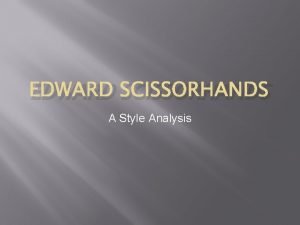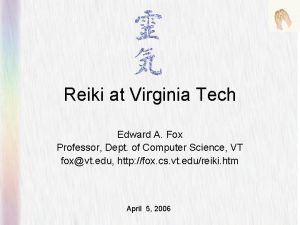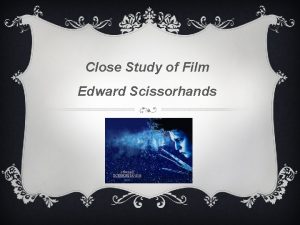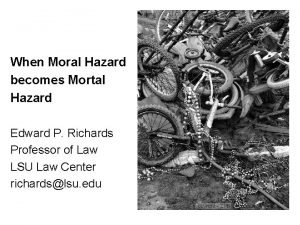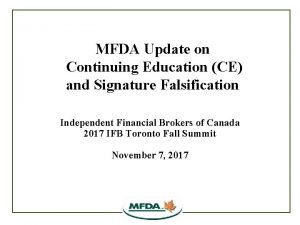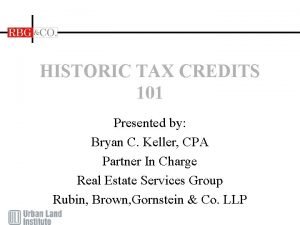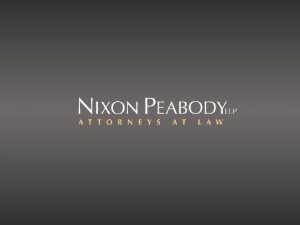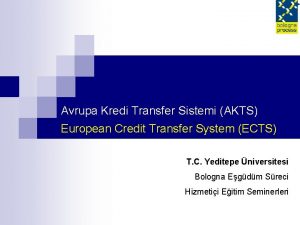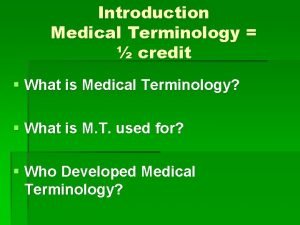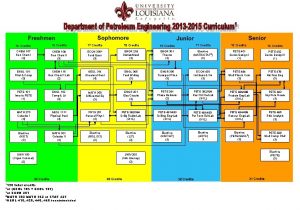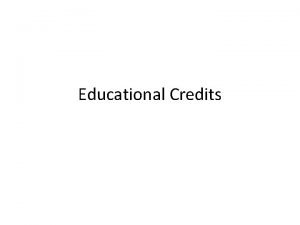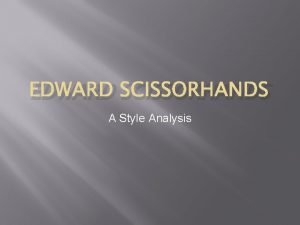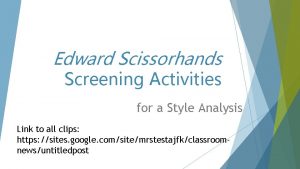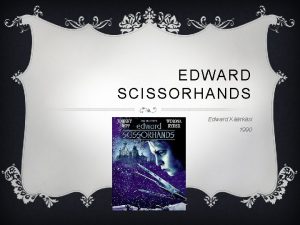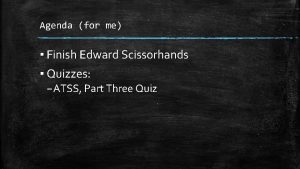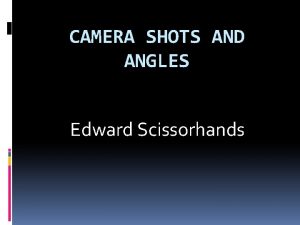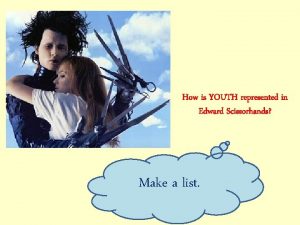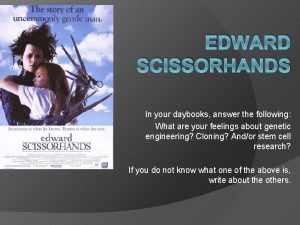EDWARD SCISSORHANDS A Style Analysis The Opening Credits















- Slides: 15

EDWARD SCISSORHANDS A Style Analysis

The Opening Credits Pages 162 -163 � � We will begin by the opening credits of the film. As we view, record your observations in the chart on page 162 about what is happening in the scene, paying close attention to images, shapes, and music.

Group Discussion 5 minutes � What can you infer or predict based on your observations?

Whole-Class Discussion Questions Hand-Up-Stand-Up-Pair-Up � With your partner, briefly discuss the following questions: � �Describe the tone in the scene. What type of movie does it remind you of? �How does the lighting help create the mood of this opening?

The Opening Scene � � We will now view the opening scene. As we view, record your observations in the chart on page 162 about what is happening in the scene, paying close attention to the way the camera moves.

Group Discussion 5 minutes � What can you infer or predict based on your observations?

Whole-Class Discussion Questions � � Hand-Up-Stand-Up-Pair-Up With your partner, briefly discuss the following questions: �How has the music changed between the opening credits and this scene? Why? �What does the camera do when it leaves the room where the story is being told? Why do you think the director does this? �What do you think this film will be about? On what do you base your prediction?

Screening Activity A Pages 164 -165 � � � Turn to your hard copy of a notes page titled “My Edward Scissorhands” viewing notes. While we watch the film, just jot down anything you notice. It can be a cinematic technique, it can be a question or thought that you have, or any general idea that pops into your mind to track your thoughts while you view. Remember that we are viewing for analysis, not for enjoyment, so you need to be actively engaged with your thoughts throughout the viewing.

Group Discussion 10 Minutes � In your groups, discuss and jot down answers to questions 1 -4. Be ready to share your thoughts!

It’s Time to Jigsaw! You are sitting in your home-base group. These are the people who will be responsible for teaching you. � Now, number yourselves off from 1 -5. � Now move to the assigned location based on your number. �

It’s Time to View � We are now going to re-watch a segment of the film. � Each numbered group will be responsible for analyzing that segment for a specific cinematic technique. Take a moment and review your assigned techniques using your flipchart. � � � 1’s…Framing/Angles 2’s…Lighting 3’s…Camera Movement 4’s…Music/Sound 5’s…Editing As we watch the film, record your notes on you’re my notes sheet for your assigned technique.

Group Discussion 5 minutes � � In your expert groups, discuss your observations and come to a consensus about what you observed. Document your agreed upon ideas in the chart on page 164.

Return to Home-Base 10 minutes � Now return to home-base and teach other what your groups observed, completing all of the columns on page 164.

Understanding the Analytic Triangle Purpose: What is the purpose of the cinematic element? Example: A purpose of a long shot is to make characters look vulnerable. Writing an an Analytical Statement: Example: When Peg is upstairs in the castle Tim Burton, in Edward Scissorhands, uses ______ (cinematic element) uses a long shot in order to show the in order to ________ (achieve what vulnerability of characters. For example, purpose). Forisexample, when Peg upstairs in the castle, the __________ (evidence long shot makes her look small soand that the effectviewer combined). worries about her safety. Examples: What are examples of where this cinematic element is used? Example: Peg looks very small in that big room. The long shot builds suspense because the viewer is worried about Peg. Effect: What is the effect(s) of this cinematic choice?

Tonight’s Homework � Write an analytic “statement” (two sentences minimum) for one of your selected cinematic elements from your style analysis thesis statement on the piece of paper provided. Writing an Analytical Statement: Tim Burton, in Edward Scissorhands, uses ______ (cinematic element) in order to ________ (achieve what purpose). For example, __________ (evidence and effect combined).
 Edward scissorhands style
Edward scissorhands style Theme of edward scissorhands
Theme of edward scissorhands Edward scissorhands virginia hat
Edward scissorhands virginia hat Edward scissorhands film techniques
Edward scissorhands film techniques Edward scissorhands moral
Edward scissorhands moral Gothic literature characteristics
Gothic literature characteristics The walking dead opening credits
The walking dead opening credits Mfda ce credits
Mfda ce credits Transfer credits vcu
Transfer credits vcu Historic tax credits 101
Historic tax credits 101 Ects
Ects Historic tax credit structure diagram
Historic tax credit structure diagram Ects credits nedir
Ects credits nedir Unc charlotte ap credit
Unc charlotte ap credit Credits medical definition
Credits medical definition Charlie werhane
Charlie werhane
